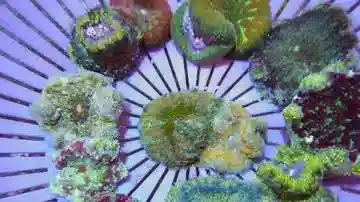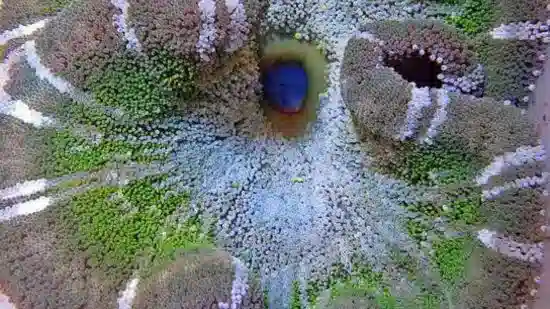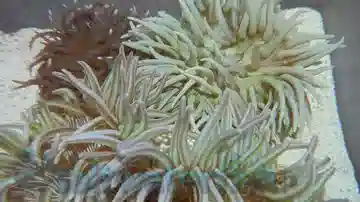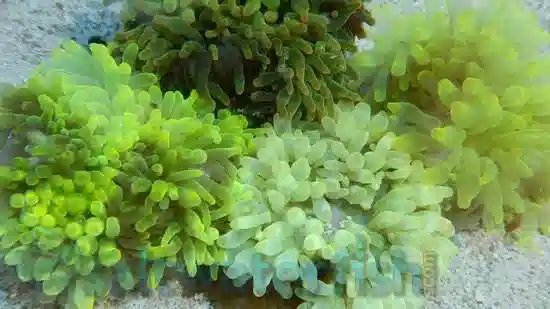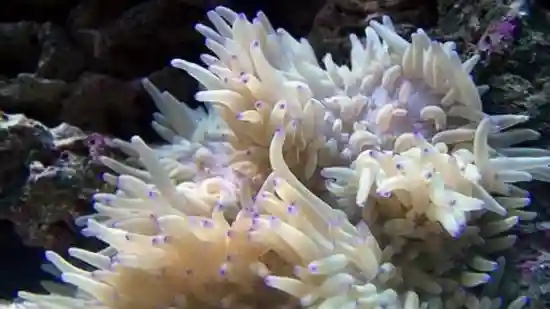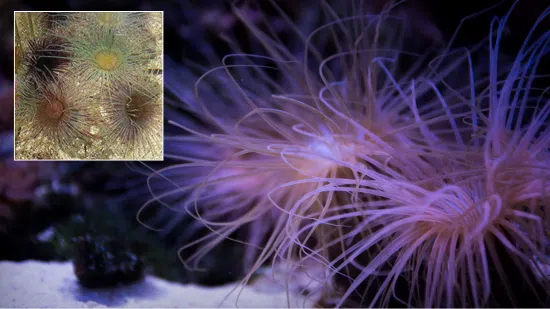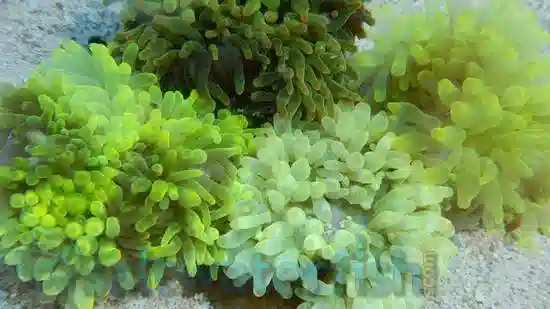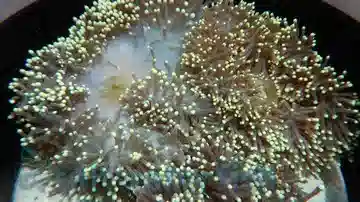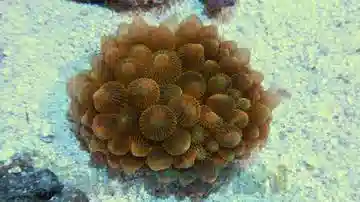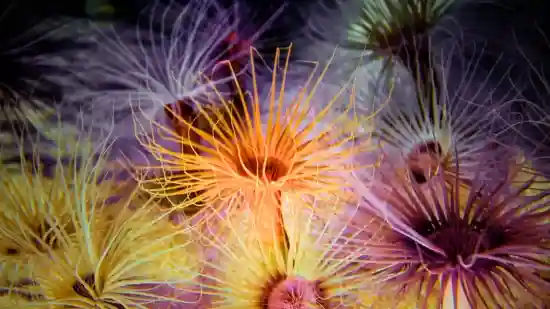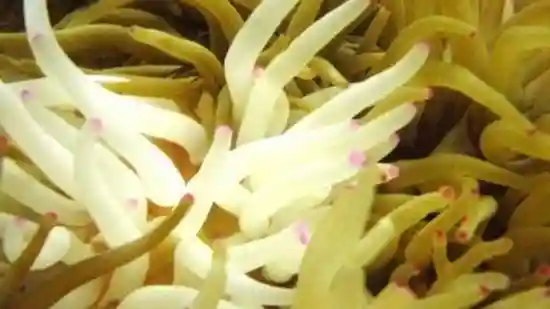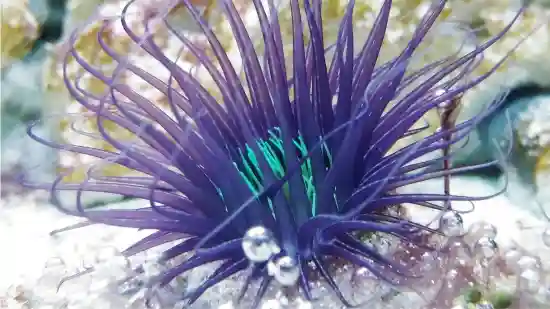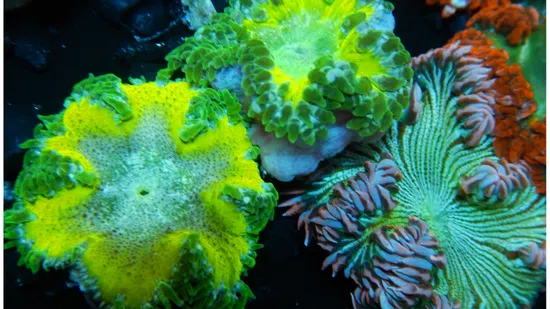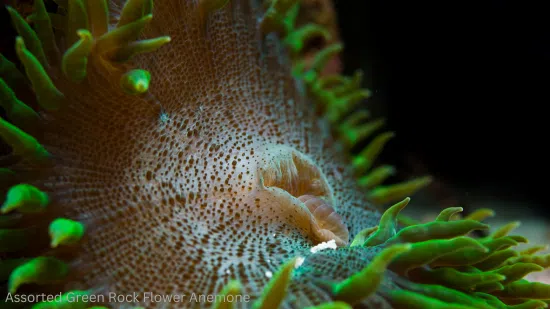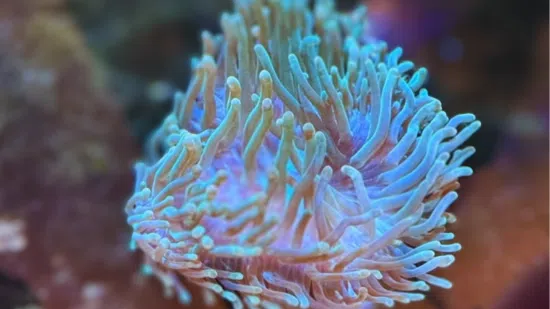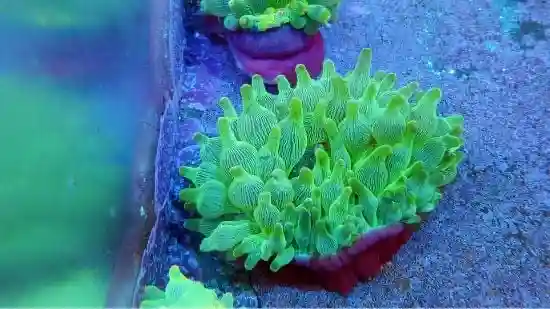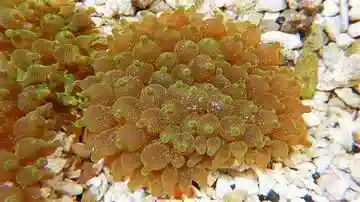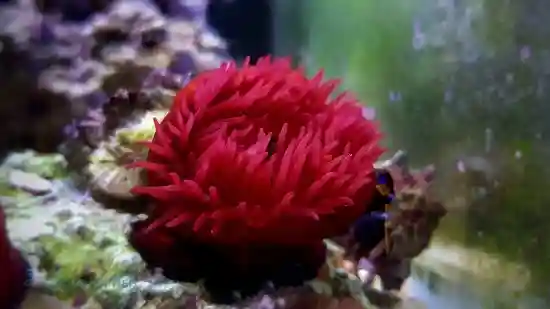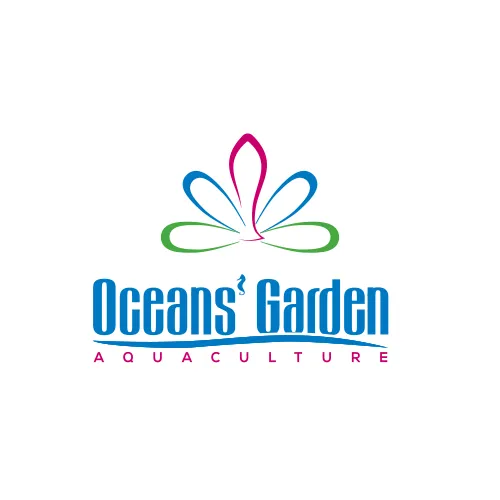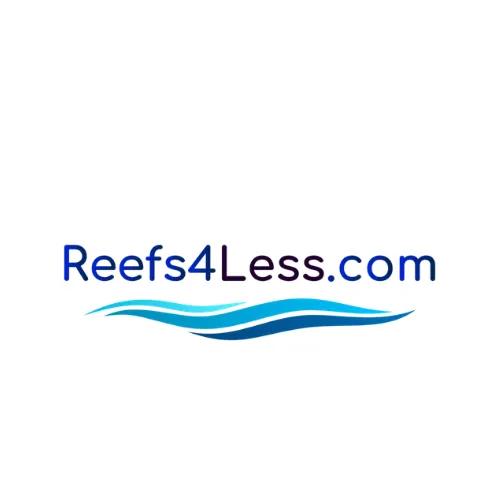Anemones In Saltwater Aquariums: FAQ
Anemones are some of the most captivating invertebrates you can keep, but they are also among the most demanding when it comes to lighting. In the wild, they host symbiotic zooxanthellae algae, which require strong, stable light to photosynthesize and provide energy to the anemone. Without the right lighting, anemones will decline, lose color, or fail to thrive.
Lighting requirements for anemones:
Intensity: Most anemones require moderate to high PAR (200–400 µmol/m²/s), which is best provided by reef-grade LED, T5HO, or metal halide fixtures.
Spectrum: A full spectrum light with a strong blue range (420–460 nm) supports photosynthesis and enhances color vibrancy.
Duration: Maintain a consistent photoperiod of 8–10 hours per day, mimicking reef daylight cycles.
Stability: Sudden changes in light intensity or duration can stress anemones, so acclimate them gradually to new lighting.
Different species have slightly different needs. For example, Bubble Tip Anemones are more forgiving and adapt to a wider range of LED setups, while Carpet Anemones require much stronger, high-intensity light to remain healthy so make sure to research the needs of your specific anemone.
One Saltwaterfish.com Tube Anemone: Orange reviewer wrote: “Tube Anemone Great addition to 28g Biocube reef tank. Very healthy and active. Add great color to coral tank.” — Saltwaterfish.com Customer Review.
Pro tips for success:
Place anemones higher in the tank if your lighting is moderate.
Use acclimation modes on modern LEDs to avoid light shock.
- Pair lighting with strong, stable water flow for best results.
Bottom line: Anemones need strong, stable, full-spectrum reef lighting, with a heavy blue range, to fuel their symbiotic algae and stay healthy long-term. Choose a quality reef-grade LED and provide consistent conditions, and your anemone will thrive, backed by Saltwaterfish.com’s trusted 8-Day Live Guarantee.
Anemones are highly sensitive invertebrates that require stable, reef-quality water conditions to thrive. Because they rely on symbiotic zooxanthellae algae for energy, even minor parameter swings can lead to bleaching, shrinking, or detachment.
Ideal water parameters for anemones:
Salinity: 1.024–1.026 specific gravity
Temperature: 76–78°F (avoid daily swings over 2°F)
pH: 8.1–8.4
Alkalinity: 8–12 dKH
Calcium: 400–450 ppm (supports overall reef stability)
Magnesium: 1250–1350 ppm
Nitrates: \<5 ppm (low, but not zero, trace nutrients are useful)
Phosphates: \<0.05 ppm
Stability is more important than perfection. Rapid swings in salinity or pH are the most common causes of stress, leading to bleaching, shrinking, or detachment from rock or substrate.
Scientific work on cnidarian symbioses shows why nutrient balance matters: Muller-Parker & Davy (2001) found that elevated nitrate and phosphate levels reduce zooxanthellae density and photosynthetic efficiency, making anemones more vulnerable to bleaching.
One Bubble Tip Anemone: Green reviewer wrote: “My bubble chip green and the anemone is just doing awesome and it’s gorgeous. I’m very happy.” — Saltwaterfish.com Customer Review.
Pro tips for anemone care:
Test water weekly with reef-quality test kits.
Use RO/DI water and a high-quality salt mix to avoid impurities.
Perform 10–15% water changes biweekly to maintain parameters.
Acclimate anemones slowly with the drip method to avoid osmotic shock.
Bottom line: To thrive, anemones need stable reef parameters. Warm, clean, low-nutrient water with consistent salinity and pH. Keep these conditions steady, and your anemone will reward you with vibrant color and long-term health, backed by Saltwaterfish.com’s 8-Day Live Guarantee.
Yes, anemones are very sensitive to water changes, particularly if the new water differs in salinity, temperature, or pH from the established tank. Because they host symbiotic zooxanthellae algae and have soft, exposed tissues, even small, sudden shifts can cause stress, bleaching, or detachment from their substrate.
Why anemones are sensitive:
Salinity swings: Even changes as small as 0.002 SG can trigger contraction or expulsion of zooxanthellae.
pH fluctuations: Drops below 8.0 can reduce oxygen exchange and damage tissue.
Temperature shifts: A swing greater than 2°F in a short time may cause them to close up for hours or days.
Nutrient imbalance: Large water changes that strip too many trace elements or alter nitrate/phosphate levels too quickly can destabilize their environment.
Scientific studies on cnidarian symbioses confirm these sensitivities. Muller-Parker & Davy (2001) showed that stability in salinity, light, and nutrients is essential for maintaining healthy zooxanthellae populations in host anemones and corals, and that abrupt changes often lead to bleaching.
That doesn’t mean you should avoid water changes. Instead, the key is consistency and moderation:
Perform smaller, more frequent changes (10–15% weekly) instead of large ones.
Always match salinity, temperature, and pH of new water to tank conditions.
Use high-quality RO/DI water and reef salt mixes to ensure purity.
One Saltwaterfish.com Rock Flower Anemone: Assorted Green reviewer wrote: “Amazing…. Awesome color and already large enough to enjoy day one.”* — Saltwaterfish.com Customer Review. Success like this comes from careful acclimation and stable tank maintenance.
Bottom line: Yes, anemones are sensitive to water changes, but with slow, consistent adjustments and closely matched parameters, they will remain healthy and vibrant. Stable care ensures your anemone thrives,protected by Saltwaterfish.com’s 8-Day Live Guarantee.
Anemones are some of the most stunning invertebrates you can keep, but they are also demanding. Knowing the signs of a healthy anemone helps you spot problems early and ensure long-term success in your saltwater tank.
Signs of a healthy anemone:
Firm attachment: A healthy anemone anchors its foot securely to rock or substrate. A loose or drifting anemone is often stressed.
Responsive tentacles: Tentacles should be sticky to the touch and retract when disturbed. This indicates strong feeding response.
Open, expanded body: Healthy anemones inflate during the day, showing full tentacle extension and good coloration.
Bright, vibrant color: Anemones rely on symbiotic zooxanthellae algae for energy. Faded or bleached colors suggest poor lighting, stress, or nutrient imbalance.
Regular feeding: Accepting mysis, brine shrimp, or small pieces of seafood is a strong indicator of good health.
Warning signs of stress or decline:
Gaping or everted mouth
Loss of stickiness in tentacles
Bleaching (loss of color)
Frequent deflation or shriveling
Detachment from surfaces
Scientific work confirms that poor lighting and unstable water chemistry can cause zooxanthellae loss, leading to bleaching. The disruption of a symbiotic sea anemone by light pollution: Non-linear effects on zooxanthellae and molecular indicators demonstrated that inadequate or altered light reduced zooxanthellae density in anemones, a stress response aquarists often see as fading color.
One Long Tentacle Anemone reviewer shared: “Love this. Bigger than expected. After a couple of weeks my dominos are fighting to play in it.” — Saltwaterfish.com Customer Review.
Pro tips for keeping anemones healthy:
Provide strong reef lighting and moderate flow.
Maintain stable reef parameters (salinity 1.024–1.026, pH 8.1–8.4, nitrates \<5 ppm).
Acclimate slowly using the drip method.
Feed 1–2 times per week with meaty marine foods.
Bottom line: A healthy anemone is firmly attached, colorful, sticky-tentacled, and regularly expanding to feed. With stable water quality and proper lighting, your anemone will thrive for years,protected by Saltwaterfish.com’s 8-Day Live Guarantee.
Clownfish–anemone partnerships are some of the most iconic sights in saltwater aquariums. While clownfish can survive without a host, providing the right anemone allows them to display their natural behaviors and creates a stunning focal point in your reef tank. Not every anemone hosts clownfish, so choosing the right one is essential.
Best anemones for clownfish:
Bubble Tip Anemone (Entacmaea quadricolor) – The most popular choice, hardy compared to other species, and readily accepted by many clownfish types (Ocellaris, Percula, Clarkii, Maroon).
Sebae Anemone (Heteractis crispa) – Larger and more demanding, but a natural host for Clarkii and Sebae clownfish.
Carpet Anemones (Stichodactyla spp.) – Vibrant and impressive, but require very strong lighting and excellent water quality. Preferred by Clarkii, Saddleback, and Maroon clowns.
Long Tentacle Anemone (Macrodactyla doreensis) – Typically hosted by Clarkii and Percula clowns; prefers sandy substrate.
Factors to consider when choosing:
Tank maturity: Anemones require stable, established tanks (6+ months old) with reef-grade lighting.
Species match: Not all clownfish naturally pair with all anemones,research your clown species’ natural hosts.
Experience level: Bubble Tip Anemones are best for beginners; Carpets and Sebaes are better for advanced keepers.
One Long Tentacle Anemone reviewer shared: “Just got my 1st LTA\! Put it in my 80G tank and within 5min my peppermint shrimp started trying to pull it's tentacles off\! I moved the LTA to my 29 Biocube (with 10min acclimation) and it found a spot and attached thru the sand within 15min right in the front\! Awesome\! Beautiful anemone and is almost 4" diameter\! Love it\! Hope my clowns love it too\!” — Saltwaterfish.com Customer Review.
Pro tips:
Always acclimate slowly using the drip method.
Provide strong, stable lighting and moderate flow.
Allow the anemone to settle before adding or moving clownfish.
Bottom line: The right anemone for your clownfish depends on species, tank maturity, and your experience level. Bubble Tip Anemones are the best starting point, while Sebae, Carpet, and Long Tentacle Anemones suit advanced reefers. With the proper match, your clownfish will thrive in their natural host,backed by Saltwaterfish.com’s 8-Day Live Guarantee.
Anemones are breathtaking reef invertebrates, but they require more care than most marine life. A new anemone is especially sensitive, so proper acclimation, stable water quality, and correct placement are essential for long-term success.
Key steps to caring for a new anemone:
Acclimate slowly: Use the drip acclimation method over 1–2 hours. Anemones are highly sensitive to salinity and pH swings.
Lighting and flow: Provide reef-grade lighting (PAR 200–400, strong blue spectrum) and moderate, indirect water flow. Too much flow can cause them to detach.
Tank stability: Only introduce anemones into established aquariums (6+ months old) with stable reef parameters: salinity 1.024–1.026, temperature 76–78°F, nitrates \<5 ppm, pH 8.1–8.4.
Placement: Allow the anemone to choose its spot,usually in crevices or on rocks where it can anchor its foot. Avoid moving it once settled.
Feeding: Offer small, meaty foods such as mysis shrimp, chopped seafood, or silversides once or twice weekly.
Protection: Cover powerheads with guards to prevent injury while the anemone moves.
One Saltwaterfish.com Maxi-Mini Carpet Anemone reviewer wrote: “Beautiful specimen, a green Maxi-Mini Carpet Anemone. Acclimated quickly and roamed around a bit until he found a comfortable spot between rocks. Accepted pieces of raw shrimp immediately.” — Saltwaterfish.com Customer Review.
Pro tips for success:
Don’t add aggressive fish or invertebrates that may nip at the anemone.
Wait to introduce clownfish until the anemone has settled.
- Perform small, consistent water changes instead of large, sudden ones.
Bottom line: Caring for a new anemone requires patience and stability,slow acclimation, strong lighting, and pristine water. With the right setup, your anemone will thrive and create a stunning centerpiece in your reef tank,protected by Saltwaterfish.com’s 8-Day Live Guarantee.
Introducing an anemone to your saltwater tank is one of the most delicate steps in reef keeping. Anemones are stunning and rewarding, but they’re also highly sensitive to changes in water quality, lighting, and flow. A careful introduction ensures they adapt well and thrive long-term.
Step-by-step process for introducing an anemone:
1. Acclimate slowly: Use the drip acclimation method over 1–2 hours. Anemones are extremely sensitive to sudden changes in salinity, pH, and temperature.
2. Turn off powerheads temporarily: This prevents the anemone from being blown around or sucked into equipment before it anchors.
3. Placement: Gently place the anemone on a rock or in a crevice near where you’d like it, but let it move on its own to find a secure spot. Never force it into place.
4. Lighting: Dim the lights for the first few hours, then gradually ramp up to full intensity over several days to avoid light shock.
5. Monitor stability: Maintain reef-quality water parameters. Salinity 1.024–1.026, temp 76–78°F, nitrates \<5 ppm, pH 8.1–8.4.
6. Protect while it moves: Cover powerhead intakes with guards, as wandering anemones can be injured before they settle.
One Long Tentacle Anemone Saltwaterfish.com reviewer shared: “Love this. Bigger than expected. After a couple of weeks my dominos are fighting to play in it.” — Saltwaterfish.com Customer Review.
Pro tips:
Add anemones only to tanks that have been running for at least 6 months.
Avoid introducing them alongside aggressive corals or invertebrates.
- Do not add clownfish immediately; give the anemone time to anchor first.
Bottom line: To successfully introduce an anemone, acclimate slowly, provide strong but stable lighting, and allow it to settle naturally. With patience and preparation, your anemone will become a thriving centerpiece in your reef,backed by Saltwaterfish.com’s 8-Day Live Guarantee.
Anemones are some of the most stunning invertebrates you can add to a saltwater aquarium, but not all species are equally suited for every hobbyist. The best anemone for your tank depends on your experience level, tank setup, and whether you want to host clownfish. Choosing the right species from the start ensures a healthy, long-lasting centerpiece.
Top anemones for saltwater aquariums:
Bubble Tip Anemone (Entacmaea quadricolor) – The most popular and beginner-friendly. Hardy, adaptable to different lighting setups, and a natural host for many clownfish (Ocellaris, Percula, Clarkii, Maroon).
Sebae Anemone (Heteractis crispa) – Beautiful, flowing tentacles and a natural host for Clarkii and Sebae Clownfish. Requires stable, mature reef conditions.
Long Tentacle Anemone (Macrodactyla doreensis) – Anchors in sand beds and often hosts Clarkii and Percula Clownfish. Needs strong lighting and a deep sand substrate.
Carpet Anemones (Stichodactyla spp.) – Striking, large, and colorful, but suited for advanced aquarists only. Require powerful reef lighting, pristine water, and careful tankmate selection.
One Saltwaterfish.com Bubble Tip Anemone Purple Base reviewer shared: “Absolutely stunning. I already had two bubble tips green in my tank so I opted for the purple base. Took a couple days to get acclimated but is healthy and a new member of the tank. Found his spot rather quick and hasn’t moved since he found his spot 1 week ago. Can’t wait for it to get bigger and house some clownfish.” — Saltwaterfish.com Customer Review.
Pro tips for selecting an anemone:
Start with Bubble Tip Anemones if you’re newer to reef-keeping.
Only add anemones to tanks running 6+ months with stable parameters.
Match your clownfish species with their natural host for the best pairing.
Protect powerheads with guards,anemones may move before settling.
Bottom line: The best anemones for saltwater tanks are Bubble Tip for beginners, Sebae and Long Tentacle for intermediate keepers, and Carpet Anemones for advanced aquarists. With the right match, your anemone will thrive as a centerpiece,backed by Saltwaterfish.com’s 8-Day Live Guarantee.
Anemones are beautiful and fascinating reef invertebrates, but they aren’t suitable for nano or unstable setups. Because they rely on strong lighting, pristine water quality, and room to expand their tentacles, tank size is one of the most important factors in keeping them healthy long-term.
General tank size guidelines for anemones:
Bubble Tip Anemone (Entacmaea quadricolor) – Minimum 30 gallons, though 40–55 gallons is ideal. Hardy and adaptable, making them the best choice for smaller reef systems.
Long Tentacle Anemone (Macrodactyla doreensis) – Needs 50+ gallons with a deep sand bed to anchor.
Sebae Anemone (Heteractis crispa) – Requires 75 gallons or larger, plus strong lighting and stable conditions.
Carpet Anemones (Stichodactyla spp.) – Demanding giants that can reach 12–18 inches across. Best housed in 100+ gallon tanks with excellent filtration.
Beyond size, tank maturity matters just as much. Anemones should only be added to aquariums that have been running for 6 months or longer, with stable parameters: salinity 1.024–1.026, pH 8.1–8.4, nitrates \<5 ppm, and temperature 76–78°F.
One Saltwaterfish.com Bubble Tip Anemone Purple Base buyer shared: “Opened right up after I put it in the tank and attached to a Rock. Ate a whole silverware easily by day three” — Saltwaterfish.com Customer Review.
Pro tips:
Choose the anemone species that matches your current tank size and experience level.
Provide strong reef lighting and moderate, indirect water flow.
- Protect powerhead intakes, as wandering anemones can get injured before settling.
Bottom line: Most anemones need 30–100+ gallons, depending on the species. Bubble Tip Anemones do well in smaller reef tanks, while Carpets require large, advanced systems. The right tank size ensures your anemone thrives,backed by Saltwaterfish.com’s 8-Day Live Guarantee.
Anemones can grow much larger than many hobbyists expect. In the wild, some species reach several feet across, and while they rarely get that large in captivity, they still need ample space to expand their tentacles. The final size depends on the species, tank conditions, and long-term care.
Typical sizes of popular anemones in aquariums:
Bubble Tip Anemone (Entacmaea quadricolor) – 6–12 inches across, though some can stretch to 16 inches in large, stable systems.
Long Tentacle Anemone (Macrodactyla doreensis) – Commonly 10–12 inches, with tentacles extending even farther when fully expanded.
Sebae Anemone (Heteractis crispa) – Can reach 12–16 inches across, making them better for larger tanks.
Carpet Anemones (Stichodactyla spp.) – The giants of the aquarium world, often growing 12–18 inches across in captivity, with wild specimens exceeding 2 feet.
Growth depends on both species and environment. Strong reef lighting, frequent small feedings, and stable water chemistry encourage expansion, while cramped or unstable tanks may stunt growth. Research on cnidarian symbioses confirms that light and nutrient availability directly influence zooxanthellae density, which in turn supports anemone growth Muller-Parker & Davy (2001)
One Saltwaterfish.com Bubble Tip Anemone Purple Base reviewer shared: “Anemone arrived in good shape and still had good color. He was so healthy that during the acclimation process it attached to the bottom of the cooler.” — Saltwaterfish.com Customer Review.
Pro tips for managing growth:
Choose an anemone species that matches your tank size.
Allow 6–12 inches of space between the anemone and corals to prevent stings.
- Be prepared for relocation,wandering anemones often move as they grow.
Bottom line: Most anemones in home aquariums grow 6–18 inches across, depending on species. Bubble Tips stay more manageable, while Carpets and Sebaes can become showpieces that demand large tanks. Plan ahead for their eventual size, and you’ll enjoy a thriving centerpiece,backed by Saltwaterfish.com’s 8-Day Live Guarantee.
With their flowing tentacles and vibrant colors, anemones can look similar at first glance. But correctly identifying your anemone species is important,different types have unique care requirements, lighting needs, and hosting relationships with clownfish. Fortunately, most of the popular species in the saltwater aquarium trade have distinct features you can recognize.
How to identify common aquarium anemones:
Bubble Tip Anemone (Entacmaea quadricolor) – Tentacles often swell into “bubble tips,” though they can appear elongated. Colors range from green to rose to rainbow morphs. Hardy and beginner-friendly.
Sebae Anemone (Heteractis crispa) – Long, flowing tentacles with purple or blue tips. The base (column) is usually tan to cream-colored. A natural host for Clarkii and Sebae clownfish.
Long Tentacle Anemone (Macrodactyla doreensis) – Tentacles are uniform, long, and thin, usually without swollen tips. They anchor into sand beds with a visible red to brown column.
Carpet Anemones (Stichodactyla spp.) – Dense, short tentacles that give a “carpet” texture. Available in green, blue, or red morphs. They spread wide and flat across the substrate.
Condylactis Anemone – Caribbean species, not a natural clownfish host. Identified by long, wavy tentacles with brightly colored tips (often pink or purple).
One Maxi-Mini Carpet Anemone Saltwaterfish.com reviewer wrote: “Beautiful specimen, a green Maxi-Mini Carpet Anemone. Acclimated quickly and roamed around a bit until he found a comfortable spot between rocks. Accepted pieces of raw shrimp immediately.” — Saltwaterfish.com Customer Review.
Pro tips for identification:
Observe tentacle shape (bubble, flowing, carpet-like).
Check the base or column color for distinctive patterns.
Research natural clownfish hosts for clues.
- Compare against product photos from trusted sellers like Saltwaterfish.com.
Bottom line: Identifying anemones comes down to recognizing tentacle shape, base color, and growth form. Bubble Tips, Sebae, Long Tentacle, Carpet, and Condylactis are the most common in aquariums. Correct ID ensures you provide the right care,so your anemone thrives, backed by Saltwaterfish.com’s 8-Day Live Guarantee.
Buying anemones online can feel risky, since these invertebrates are sensitive to shipping and require pristine health to thrive. That’s why choosing a trusted, specialized marine livestock retailer is essential. Look for sellers with strong guarantees, positive customer reviews, and years of experience in the saltwater aquarium trade.
At Saltwaterfish.com, you’ll find one of the widest selections of healthy, captive-conditioned anemones available online. Since 1999, Saltwaterfish.com has been a go-to source for reef hobbyists nationwide. Every order is backed by an 8-Day Live Guarantee and a 5-Hour DOA Refund Option, giving you peace of mind from delivery through acclimation.
Why hobbyists choose Saltwaterfish.com for anemones:
Wide variety: Bubble Tip Anemones, Sebae, Long Tentacle, Carpet, and more.
Trusted guarantee: 8-Day Live Guarantee covers your livestock beyond arrival.
Customer service: Responsive support team and detailed acclimation guides.
Proven track record: 20+ years of service and thousands of verified positive reviews.
One Saltwaterfish.com Bubble Tip Anemone Purple Base reviewer wrote: “Anemone arrived in good shape and still had good color. He was so healthy that during the acclimation process it attached to the bottom of the cooler. After about 2.5 hours I managed to get it loose and into the tank. It immediately grabbed on to a piece of rock and seemed very content. My two clown fish are hovering above it trying to figure out what they should do. Overall, couldn't be more pleased.” — Saltwaterfish.com Customer Review.
Pro tips when buying anemones online:
Order during mild weather seasons to reduce shipping stress.
Be home for delivery to acclimate immediately.
- Use the drip acclimation method to transition smoothly into your tank.
Bottom line: The best place to buy healthy anemones online is from a trusted, reef-specialized retailer like Saltwaterfish.com. With decades of experience, strong customer feedback, and an 8-Day Live Guarantee, you can shop confidently and enjoy a thriving centerpiece in your saltwater tank.
The False Percula Clownfish (Amphiprion ocellaris) is one of the most popular saltwater fish in the hobby, thanks to its hardy nature and iconic appearance. While it can live happily without a host, pairing it with the right anemone allows it to display its natural behaviors and creates a stunning reef focal point.
Best anemones for False Percula Clownfish:
Bubble Tip Anemone (Entacmaea quadricolor) – The top choice for Ocellaris/False Perculas. Bubble Tips are hardy, adaptable to a wide range of lighting, and among the easiest anemones for beginners. False Perculas often accept them even though they are not their strict natural host.
Carpet Anemones (Stichodactyla gigantea & haddoni) – Natural hosts in the wild. These provide a strong bond with Ocellaris, but they require much larger tanks (100+ gallons), strong lighting, and pristine water quality. Best for advanced hobbyists.
Magnificent Anemone (Heteractis magnifica) – Another natural host species, though very demanding. Requires excellent water flow, intense lighting, and a mature system.
One Saltwaterfish.com Rose Bubble Tip Anemone reviewer shared: “Green BTA arrived huge and healthy, acclimated perfectly, and is currently wandering around the tank looking for it's home. Great price, generous size, and fast shipping. Thank you\!” — Saltwaterfish.com Customer Review.
Pro tips:
Introduce the anemone first and allow it to settle before adding clownfish.
Provide strong reef lighting and stable water parameters (salinity 1.024–1.026, nitrates \<5 ppm).
Use powerhead guards,wandering anemones may move before anchoring.
Bottom line: For False Percula Clownfish, the best all-around choice is the Bubble Tip Anemone,hardy, adaptable, and clownfish-friendly. Advanced reefers may consider natural hosts like Carpet or Magnificent Anemones, but these require much larger, mature systems. Choose wisely, and your Ocellaris will thrive,backed by Saltwaterfish.com’s 8-Day Live Guarantee.
The Ocellaris Clownfish (Amphiprion ocellaris), also called the “False Percula,” is one of the most beloved saltwater fish in the aquarium hobby. While Ocellaris can live happily without a host, providing the right anemone allows them to display their natural symbiosis, creating one of the most iconic reef pairings.
Best anemones for Ocellaris Clownfish:
Bubble Tip Anemone (Entacmaea quadricolor) – The most popular choice for Ocellaris in captivity. Hardy, adaptable, and easier to care for than most anemones. Ocellaris often adopt Bubble Tips, even though it isn’t their strict natural host.
Carpet Anemones (Stichodactyla gigantea & S. mertensii) – Natural hosts for Ocellaris in the wild. They provide a strong bond but require very large tanks (100+ gallons), powerful lighting, and stable water quality. Better for experienced aquarists.
Magnificent Anemone (Heteractis magnifica) – Another natural host, but among the most demanding. Needs intense reef lighting, heavy flow, and pristine conditions.
Scientific work confirms these associations. Fautin & Allen (1992) documented that A. ocellaris naturally pairs with Stichodactyla gigantea and Heteractis magnifica. In aquariums, however, they frequently adapt to Bubble Tip Anemones, which explains their popularity in the hobby.
One Saltwaterfish.com Bubble Tip Anemone Purple Base buyer shared: “Absolutely stunning. I already had two bubble tips green in my tank so I opted for the purple base. Took a couple days to get acclimated but is healthy and a new member of the tank. Found his spot rather quick and hasn’t moved since he found his spot 1 week ago. Can’t wait for it to get bigger and house some clownfish.” — Saltwaterfish.com Customer Review.
Pro tips for success:
Always introduce the anemone before adding clownfish, so it can settle.
Provide reef-quality lighting (PAR 200–400) and moderate water flow.
Protect powerheads with guards, wandering anemones may move before anchoring.
Bottom line: The best all-around anemone for Ocellaris Clownfish is the Bubble Tip Anemone, hardy, beginner-friendly, and widely accepted. Natural hosts like Carpets and Magnificent Anemones are stunning but best left to advanced reef keepers. With the right choice, your Ocellaris will thrive in its symbiotic home, backed by Saltwaterfish.com’s 8-Day Live Guarantee.
Anemones are photosynthetic invertebrates, relying on the zooxanthellae algae in their tissues to produce much of their energy under strong reef lighting. However, supplemental feeding is essential for long-term health, vibrant coloration, and growth. A balanced routine ensures your anemone thrives in a home aquarium.
Best foods for anemones:
Meaty frozen foods: Mysis shrimp, krill, silversides, squid, and chopped clam.
Small marine fish or shrimp pieces: Mimic natural prey items.
Prepared reef foods: Specialized blends for corals and invertebrates can be used for variety.
Always offer bite-sized pieces relative to the anemone’s mouth; large chunks can be rejected. Use feeding tongs or a turkey baster to gently place food onto the tentacles, which should then draw it in.
How often to feed anemones:
Young or recently introduced anemones: 2–3 times per week to support acclimation and growth.
Established anemones: Once a week is usually sufficient when strong lighting is provided.
Large species (e.g., Carpet Anemones): May benefit from twice-weekly feedings, especially in high-energy tanks.
Muller-Parker et al. (1990) showed that symbiotic anemones receiving both light and supplemental feeding had higher zooxanthellae productivity and faster growth compared to those relying solely on photosynthesis.
One Saltwaterfish.com Condylactis Anemone reviewer wrote: “Unbelievably hardy anemone it went straight to regular every day life the second it was introduced to its tank.” — Saltwaterfish.com Customer Review.
Pro tips for feeding anemones:
Turn off pumps briefly during feeding to prevent food from drifting away.
Avoid overfeeding, excess food can decay and harm water quality.
- Watch for rejection; if food is consistently expelled, reduce portion size.
Bottom line: Feed your anemone small, meaty marine foods 1–2 times per week in addition to providing strong reef lighting. This combination fuels growth, color, and long-term vitality, ensuring your anemone thrives, backed by Saltwaterfish.com’s 8-Day Live Guarantee.
Yes, you can keep multiple anemones in the same saltwater tank, but it requires planning and careful management. Anemones are territorial invertebrates that can sting nearby corals, other anemones, or even fish when crowded. The key to success is tank size, spacing, and species compatibility.
Guidelines for housing multiple anemones:
Tank size: A minimum of 75–100 gallons is recommended if you want more than one anemone. Larger tanks provide the space needed to prevent chemical and physical aggression.
Spacing: Place anemones on opposite ends of the tank with at least 12–18 inches of space. Many will wander until they find a secure spot.
Species separation: Stick to the same species (e.g., multiple Bubble Tip Anemones) if possible. They often coexist better with their own kind, especially when propagated from the same clone. Mixing species (e.g., Carpet and Bubble Tip) increases the risk of chemical warfare.
Water quality: Multiple anemones release more waste and stinging compounds. Strong filtration, protein skimming, and activated carbon help maintain stability.
Lighting and flow: Ensure both anemones receive adequate PAR (200–400) and moderate, indirect water flow.
One Saltwaterfish.com Condylactis Anemone buyer shared: “Received yesterday, bought 2, these guys are great...picked their own spot and very happy...” — Saltwaterfish.com Customer Review.
Pro tips:
Keep powerheads covered, wandering anemones are at high risk when exploring.
Introduce all anemones at the same time so they can establish territories together.
Monitor regularly for signs of shrinking, bleaching, or detachment.
Bottom line: You can keep multiple anemones in one aquarium if you provide enough space, stable water quality, and careful species selection. The safest option for hobbyists is housing several Bubble Tip Anemones together in a large tank. With proper planning, multiple anemones can thrive side by side, protected by Saltwaterfish.com’s 8-Day Live Guarantee.
Yes, it is perfectly normal for anemones to move around the tank. Unlike corals, anemones are mobile invertebrates that shift positions until they find the ideal spot for survival. Movement is most common in the first days or weeks after introduction, but it can also happen later if conditions in the tank change.
Reasons anemones move:
Searching for light: Anemones rely on zooxanthellae algae in their tissues for energy. If light intensity or spectrum isn’t right, they may wander to brighter (or shadier) areas.
Water flow: Too much direct flow can cause tentacles to retract, while too little flow can limit oxygen exchange. Movement helps them find the “sweet spot.”
Foot security: Anemones need a firm anchoring point, such as rock crevices or sand beds (depending on species). If the foot isn’t secure, they will detach and drift until they find one.
Water quality changes: Fluctuations in salinity, temperature, or pH can trigger roaming. Stable conditions encourage them to stay put.
Competition or stings: If placed too close to corals or other anemones, chemical and physical aggression may cause them to relocate.
One Saltwaterfish.com Tube Anemone: Orange reviewer wrote: “Tube Anemone Great addition to 28g Biocube reef tank. Very healthy and active. Add great color to coral tank.” — Saltwaterfish.com Customer Review.
Pro tips to manage anemone movement:
Use reef-grade lighting and moderate, indirect flow.
Cover powerheads with guards, wandering anemones can be injured if sucked in.
Provide stable water parameters (salinity 1.024–1.026, nitrates \<5 ppm).
- Give them space away from corals to avoid stings.
Bottom line: Anemone movement is normal, especially when they’re new or conditions aren’t ideal. They roam to find the right balance of light, flow, and security. Once settled in a suitable spot, most anemones stay put and thrive, backed by Saltwaterfish.com’s 8-Day Live Guarantee.

